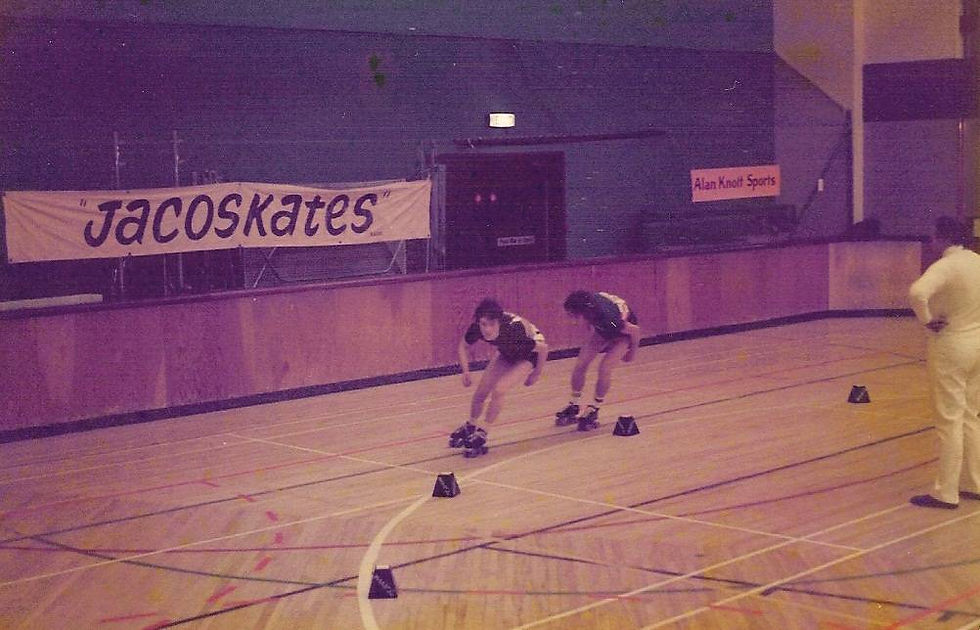BRITISH SKATING LEGENDS
Friday 12th June 1970 saw Herne Bay lose it's beloved Grand Pier Pavilion as it was burned to the ground after standing for almost 60 years. However, as the embers still smouldered there were already plans afoot to replace the iconic structure.
In 1971 John C. Clague presented his design for a new Pier Pavilion that would stand in the place where the old Grand Pavilion once lit up Herne Bay's pier. Over the next few years there was much toing and froing with regards to funds but on 5th September 1976 Herne Bay once again had a Pier Pavilion and more importantly, a new home for local roller skating. Opened by former Prime Minister, Sir Edward Heath, the opening was a grand affair. The ceremony was supported by over 2000 people and the day was marked by a series of sporting events in the new sports hall, not least of which was some roller skating races.
At a cost to build of some £900,000 the new Pier Pavilion (known locally as "The Cowshed") was soon in regular use. On 20th November 1976 the Stableford Cup event was run for the first time since 1969. Fittingly the trophy was the last race to be run before the old pavilion burned down. Now, seven years on, it was the first recognised trophy to be held at the new venue. Wayne Lee (Southern) would come home the winner just ahead of GB international Mick McGeough (Alexandra Palace). The event was once again hosted by the Herne Bay United Roller Hockey and Speed Club. Secretary of the club was a certain Jim Lipyeat, winner of the 1959 One Mile Championship on the old rink.

By the time the 1977/78 season started, Herne Bay once again had two distinct skating clubs, Herne Bay United and the newly formed Herne Bay Flyers. Lipyeat had decided that as Herne Bay United focused primarily on hockey he would set up another club whose sole focus was on speed skating. And so, on 16th October 1977 the Herne Bay Flyers team took to the track for the very first time.
The club would hold its first race on the William Street car park circuit in June 1978 but at the very start of the 1978/79 season the club held the first of what would become a successful two day international meet. October 21st saw the first days racing which included events at the Pier Pavilion before racing resumed on the second day on William Street.
On 14th April 1979 Herne Bay United RH &SC held the Stableford Cup and Madelin Dauncey Trophy events for the very last time at the Pier Pavilion. The Stableford Cup had first been raced for in 1938 (coincidentally the same year that Jim Lipyeat was born) but interest in speed for the club had waned. Without any speed skaters of their own they called time on speed skating and concentrated solely on their hockey exploits. Herne Bay Flyers, on the other hand, were going from strength to strength.
1980 was the first year a Junior European Championship event was held and of the five boy skaters in the British team, three of them skated for Herne Bay Flyers - Rohan Harlow, Jamie Godden and John Quinney. In 1981 three of the four boys and one of the girls would make up the British team (Rohan Harlow, Ian Ashby, Simon Burgess and Dawn Birch) with Harlow becoming Britain's first junior medallist (2nd in the 5000 metres).
The Pier Pavilion was very much a training base for this group of talented youngsters, especially in the winter months, but racing here was few and far between. In fact, 2nd December 1984 saw the very last official race held on Herne Bay Pier. It seemed that the new building had none of the character of the old Grand Pavilion and speed skating as a whole seemed to now favour outdoor racing.

Skating in general continued at the Pier Pavilion and hockey matches were regularly contested here. In 1994 an exhibition of speed skating was organised that included the British team of that time, but club racing was now a thing of the past. In fact, the Herne Bay Flyers club disbanded at the end of the 1989/90 season driving another nail in the coffin of speed skating within the Herne Bay community.
By 2010 the maintenance costs to keep the Pier Pavilion open were coming under close scrutiny and the decision to keep open the venue was not deemed viable. In April 2012 demolition of this second Pier Pavilion commenced. 60 tonnes of asbestos were removed and 4000 tonnes of concrete, scrap iron and timber were gradually taken away. At a cost of £750,000 (more than three quarters the cost paid to build it) the final piece of the Pier Pavilion was dismantled and the Herne Bay sky line changed once more.
The pier reopened in June, just two months after demolition had started. Albeit, other than an unforced hiatus between 1969 and 1976, Herne Bay Pier had hosted roller skating for 100 years, but no more. It's true, the "Cowshed" was a typical stark 1970's structure and it could never replace the romance of the old Grand Pier Pavilion, but for a short period of time it was the home of one of the most successful British clubs and kick started the skating careers of some of the country's most successful British speed skating legends. Despite never having held a British Championship event, for that reason alone it deserves a mention amongst some of Britain's most famous rinks.


